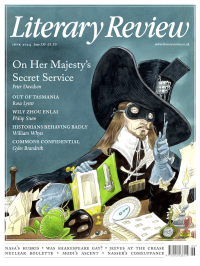Darrin M McMahon
Planet of the Killer Apes
The Invention of Prehistory: Empire, Violence, and Our Obsession with Human Origins
By Stefanos Geroulanos
W W Norton 512pp £22.99
‘There’s something about caves,’ Stefanos Geroulanos observes towards the end of this deft and provocative book. They devour and block out the light, forcing us to listen, to see with our minds. Those musings serve as an introduction to a chapter on the modern discovery of prehistoric cave paintings in such places as Altamira and Lascaux. ‘To experience the caves’, Geroulanos writes, ‘is to situate them in a history of the imagination’, one that takes in the Odyssey, the Oresteia, Plato’s philosophy, the Bible, Nietzsche and, in our own day, a host of bestsellers.
If to imagine is what we must do whenever we think about the past, we must do so especially hard when it comes to those who lived in times for which there are no written records. That is the territory into which The Invention of Prehistory ventures. The book is a study of the narcissistic fantasies that human beings have projected onto the deep past. Prehistory, Geroulanos says, and the ‘obsession’ with human origins that attends its study, has ‘never really been about the past’. It is about the concerns and needs of the present. In tracing the often-disturbing ways that prehistory has been put to work, he uncovers a brutal history of empire, violence and domination.
The book opens in the 18th century, when writers like Jean-Jacques Rousseau fantasised about the state of nature and pondered the growth of humanity through successive stages of development, from barbarism to civilisation. These writers seeded a crucial connection, linking the world’s surviving indigenous peoples to humanity’s first born. Indigenous

Sign Up to our newsletter
Receive free articles, highlights from the archive, news, details of prizes, and much more.@Lit_Review
Follow Literary Review on Twitter
Twitter Feed
It wasn’t until 1825 that Pepys’s diary became available for the first time. How it was eventually decrypted and published is a story of subterfuge and duplicity.
Kate Loveman tells the tale.
Kate Loveman - Publishing Pepys
Kate Loveman: Publishing Pepys
literaryreview.co.uk
Arthur Christopher Benson was a pillar of the Edwardian establishment. He was supremely well connected. As his newly published diaries reveal, he was also riotously indiscreet.
Piers Brendon compares Benson’s journals to others from the 20th century.
Piers Brendon - Land of Dopes & Tories
Piers Brendon: Land of Dopes & Tories - The Benson Diaries: Selections from the Diary of Arthur Christopher Benson by Eamon Duffy & Ronald Hyam (edd)
literaryreview.co.uk
Of the siblings Gwen and Augustus John, it is Augustus who has commanded most attention from collectors and connoisseurs.
Was he really the finer artist, asks Tanya Harrod, or is it time Gwen emerged from her brother’s shadow?
Tanya Harrod - Cut from the Same Canvas
Tanya Harrod: Cut from the Same Canvas - Artists, Siblings, Visionaries: The Lives and Loves of Gwen and Augustus John by Judith Mackrell
literaryreview.co.uk